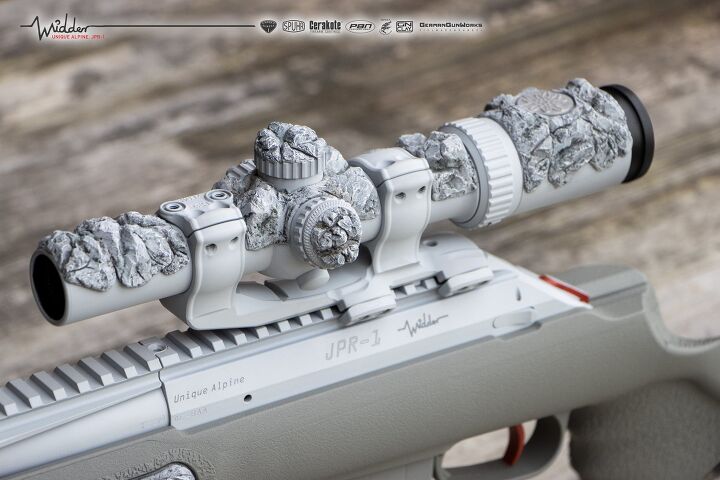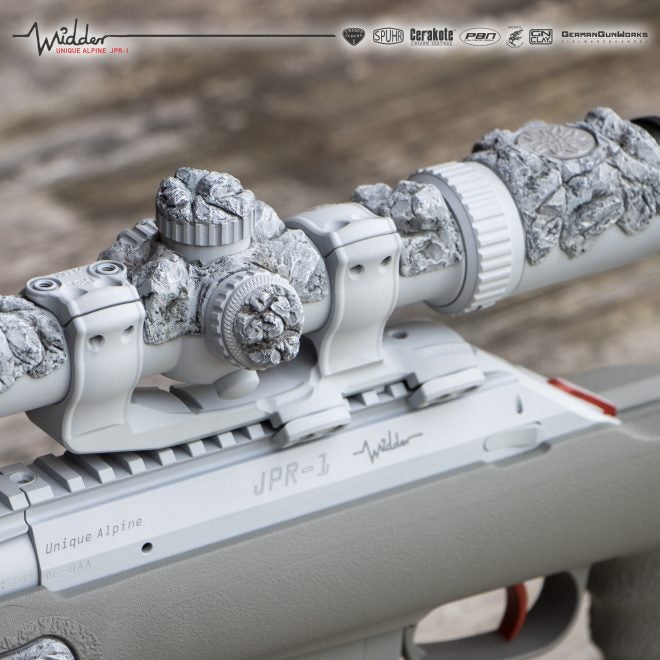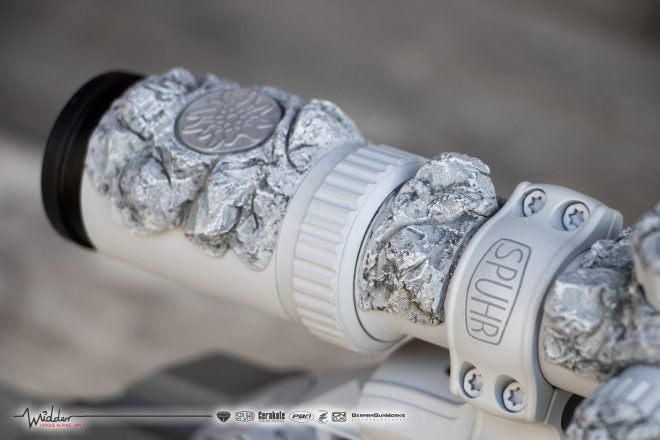Over the years, German GunWorks have enriched us with various interesting projects, and it’s now time for a TFB exclusive: The Widder Project, which is German for Aries/Ram. Here you can see a JPR-1 Nordland Scout rifle made by Unique Alpine transformed by multiple technologies, and explained in depth for those who want to understand in detail.
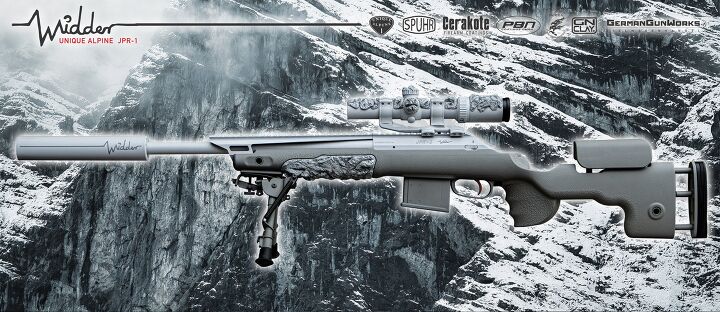
GermanGunWorks @ TFB:
- German GunWorks’ exceptional G29 VIPER Project – Haenel RS9 in .338 LM
- The amazing German GunWorks G29 Viper
- German GunWorks Heckler & Koch MR223 A1 “Keiler”

Here is the exclusive for TFB explanation of the project. The text has been machine-translated from German in case you find some funny wordings:
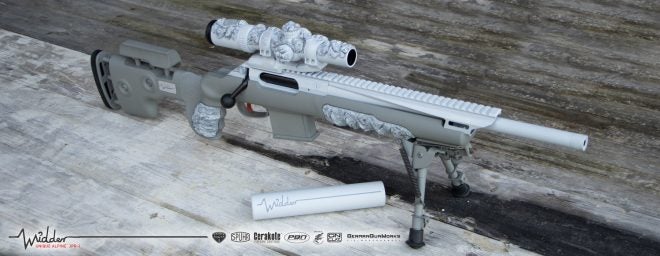
Would you like something different? The GermanGunWorks Widder Project
Anyone who knows GermanGunWorks as a company is aware that thy like to tune and convert firearms like no one else. Of course, the majority of the conversions are what you would call classical, but some of them also stand out. A lot. The Widder project is such a project for sure.
The project is probably the first large-caliber firearm whose surface was not engraved or milled, but modeled with the most modern materials. For many, this new method may seem strange at first and certainly polarize a bit visually, but the know-how behind it, as we will find out later, has it all.
The project partners
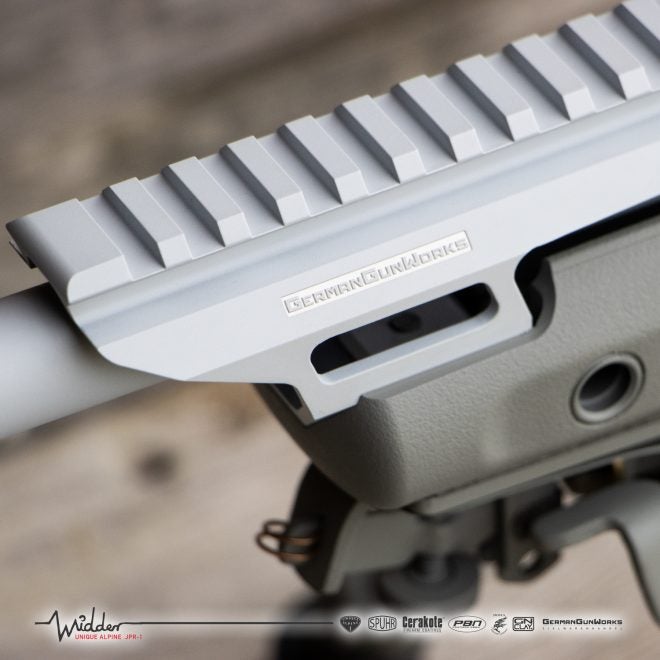
This project was realized by Unique Alpine, Spuhr, Cerakote, GnClay, PBN Coatings, Sierra Weapon Coating, Harris and GermanGunWorks. All of them well-known names from greats in their branch and specialists in their field. Each of them was able to bring their strengths to bear in the project.
The basis – JPR-1 Nordland Scout
The basic weapon JPR-1 Nordland Scout from the company Unique Alpine AG is a hybrid of a weapon for official as well as hunting / sporting use. In itself, the weapon already has very good properties. Only 91cm total length (without silencer) with a barrel length of 16.5 “(419mm), an adjustable pressure point trigger (900-2500g / preferred travel / trigger stop / locking overcut) and an extremely ergonomic shaft from GRS in conjunction with high precision and sufficient picatiny length (STANAG 4694) for special accessories.
The weapon is handy, easy to handle and equipped with a heavy match barrel and 5 / 8-24 UNEF muzzle thread. As shown here in the .308 Win caliber, it is a reliable precision tool for use as well as for hunting or sport shooting. All of this at a basic price of € 2298.
The JPR-1 is very ammunition compatible, which also has great advantages. With the 1 MOA precision guarantee, each weapon is delivered with a proof of the shot. The manufacturer secretly goes further, because even if a weapon is at a ½ MOA deviation, you are already troubleshooting! The best results were achieved with the 165 green Hornady SST, RWS Hit and Target Elite Plus.This precision is no coincidence, because Unique Alpine manufactures the weapon according to official standards, as these models are also regularly used by police units, for example. It is officially available in the calibers .243 Win, 6.5CM, 6.5×47 Lapua and .308 Win. Two other calibers should also be available to order – 6mm Creedmore and 450 Bushmaster.
We welcome the fact that the system itself is very Mauser heavy. If you want to develop a good hunting and duty repeater, you cannot avoid the ideals of the Mauser system. This means that the trigger can be exchanged for other Mauser 98 triggers, which we do not recommend, however, as an excellent trigger has already been installed. The firing pin has a firing pin safety device and it is a three-lug lock.
The lock was designed in such a way that it works with a lock distance of 0mm based on the primary pull-out. It opens 7/10 and closes 7/10, which counteracts case jams very strongly and enables the cleanest repeating. The breech and its function thus contribute significantly to the high precision of the weapon.
The ejector is built into the housing and also has a great feature. If you repeat quickly, it ejects the cases accordingly strongly. If you repeat slowly, however, he literally hands you the case from the ejection window.
There was no slouch in any other area either. The barrel is gas nitrided, the system case, bolt, firing pin and the firing pin flag are DLC-coated. Here, too, maximum processing quality, which also has emergency running properties – should there ever be a shortage of oil. Of course, GGW made sure not to remove the DLC coating when repainting, which is why the weapon now even has double protection. The magazines are AICS compatible and therefore fit into every Tikka CTR / UPR etc.
The JSD-1 hunting silencer is also from Unique Alpine and is extremely robust and durable. With an outer stainless steel housing and titanium internals, this has a damping effect of approx. 25dB.
The overall JPR-1 system is something special, which you may not see at first glance without this background knowledge. The JPR-1 is therefore definitely worth the money – a perfect basis for the project.
The goal
Apart from repainting, laser engraving and modeling, the weapon should be kept within a financially acceptable range. For this reason, GGW relied on tried and tested methods such as the use of a Harris S-BRM bipod, a hunting Spuhr mount and a 1-4x driven hunt lens from Burris. All in all, all components that do their job excellently without drifting into spheres that are too expensive. In short, in contrast to many of the tuner’s other projects before, this weapon can also be afforded with normal earnings.
The Spuhr Montage (SCP-3022) is from the Swedish manufacturer’s Hunting series and was deliberately chosen as a cantilever (offset block assembly) based on the eye relief selected for the glass in combination with the weapon. Depending on the position of the shooter’s head, a regular assembly would otherwise have to be partially placed on the Picatinny rail of the handguard, which must be prevented. With this choice you keep all options open and offer maximum flexibility. The existing ISMS interface on the front ring could be used to attach a small red dot sight.At least in Germany you know that GermanGunWorks, based on its long-term cooperation with Spuhr, not only gives a good picture in terms of projects, if you are looking for the best prices for Spuhr assemblies and stop by the GermanGunWorks shop.
With the Harris bipod (S-BRM) it doesn’t look any different. Sure there are now more modern and “fancier” solutions, but the American bipods with cult status are still the most reliable and robust systems on the market. So if you get an original and not one of the many copies of the bipod, you have a bipod that will last forever.
The paintwork

Also this time PBN Coatings was on board, which is the general importer for Cerakote in Germany. GGW has relied on this cooperation for years, because Cerakote Lack still has no serious competition in terms of quality, properties and handling.
The colors 213 Battleship Gray and 214 Bull Shark Gray from the manufacturer’s H series were selected. The H series is a two-component lacquer that is baked in the oven after it has been lacquered.
With many years of experience in handling paints, it must be said that Cerakote cannot be painted by everyone. A correct procedure in the areas of surface treatment, degreasing, painting and curing are crucial in order to obtain a perfect result and to bring all the positive properties of the ceramic lacquer to bear.
In this project too, getting it right meant that GGW completely dismantled the weapon and blasted all parts with corundum in the correct grain size. Afterwards, grease residues were removed chemically and thermally in order to provide an optimal primer.
With Sierra Weapon Coatings a reliable and high quality partner has been found who applied the base coat to the weapon. Specializing in gun coating, the small Franconian company did a fantastic job in terms of the lacquer and surface quality of the Cerakote lacquer.
It doesn’t sound like much, but painting a gas-filled riflescope with the H-series (which is oven-drying) is quite an achievement. If you choose too high a temperature in the oven you will have effects that you would rather not (a ZF If the temperature is too low, the paint will not cure properly and will have poorer properties. So Sierra Weapon Coating knows exactly how to do it right.
GnClay modeling
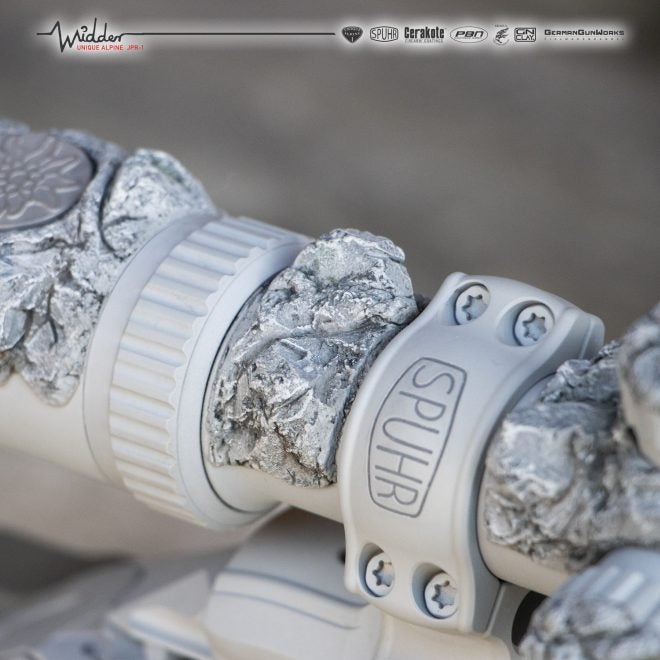
But now we come to something completely new – the 3D modeling of the Aries!
Man has decorated his weapons for millennia. In the area of firearms and knives, traditionally, there has usually only been the option of creating decorations or surfaces by engraving or repainting. A change in shape was thus previously only possible by removing material by engraving or milling. In Germany, this can only be done by qualified persons (e.g. gunsmiths), it is very time-consuming and usually requires a new fire in the case of firearms. In addition, there are considerable limits to the shaping of the possibilities in classic weapon processing. GnClay now closes this gap by making it possible for everyone to model shapes and structures.
GnClay or also (pronounced Gun Clay) is a two-component modeling clay specially developed for use on firearms. The properties of the mass make it possible to model a wide variety of structures on various parts of the rifle and thus ensure either permanent decoration or camouflage of the weapon. There are hardly any limits to the craftsmanship of the designer, because GnClay can be processed excellently and, above all, dimensionally stable and rich in detail.
At the moment, the GnClay developed by GermanGunWorks is not yet ready for the civil market, because the processing is currently still too complex and there is a lack of investors with the necessary capital for mass production and the associated effort. But let’s see what the future brings.
So if you are interested in such work on your weapon yourself, you cannot avoid having the work done directly at GermanGunWorks.
Civil use:
A brand new development like GnClay will initially polarize something like many innovations in the weapon sector. Guns used to have almost exclusively wooden stocks and when plastic stocks appeared in the 1960s, this was viewed with skepticism at first. Weapons also always had to be black or silver. Then the first colored lacquers specializing in weapons came onto the market a few years ago and today weapons with a wide variety of colors, patterns and paintwork are no longer an unfamiliar sight. With GnClay you only take the logical step of bringing the previously painted-on shapes from 2D into the 3-dimensional. The modeling clay enables visually appealing shapes and surfaces to be realized on the one hand and, on the other hand, for example, cheek pads or handles to be optimally and ergonomically adapted to yourself. There are hardly any limits to the imagination.
Business use:
As early as the late 1990s, units like the US Navy SEALs were experimenting with 3D surfaces on their helmets and weapons to improve contours and night vision retroreflective values. The result was helmets and weapons that were brought onto the weapon with acrylic / silicone lines and painted over. The options were very limited and not optimal. GnClay, on the other hand, is light, robust, malleable and can be designed in such a way that the contours are broken significantly. In addition, it can be painted over and can therefore also significantly optimize the night vision reflection value with e.g. Cerakote ceramic paint. In the area of sniping, the product e.g. snipers gives the opportunity to develop the weapon permanently with less noticeable contours. It does not matter whether it is realistic replicas of surfaces (e.g. tree bark, stones, leaves, etc.) or fantasy structures – there are hardly any limits to what can be shaped. The advantages of GnClay are not limited to weapons, but can be applied to all “hard” objects. This includes modeling for contour breaking on helmets, spotting scopes, tripods, laser markers, rangefinders, etc.
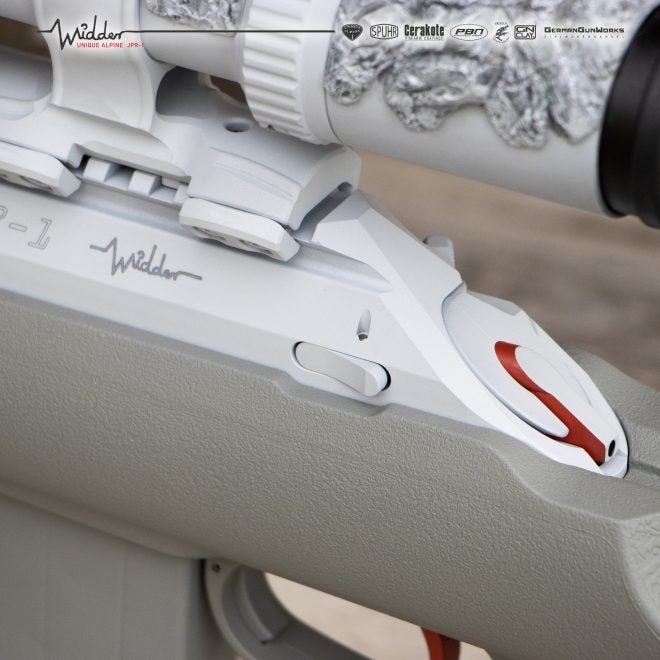
Characteristics:
The modeling clay is characterized by the following points:
Two-component modeling clay with a simple 50/50 mixing ratio
Self-curing (air-drying)
Dimensionally stable (does not melt)
Very hard after curing
Very detailed modeling possible (consistency of good modeling clay during processing)
No shrinkage or cracking during curing
Waterproof after curing
Heat-resistant up to 200 ° C / non-flammable
Cold-resistant down to -30 ° C
Shock Resistant
Forms a strong bond / sticks firmly to itself, metal, ceramic, wood, stone, plastic, fiberglass
Depending on the processing and outside temperature, it can be modeled for up to 3 hours after mixing.
Cures within 24 hours
The base material can be colored
Bases of different colors can be mixed
Can be used for molding various substrates
Available in the colors: white, black, gray, green, brown
Synthetic resin base
After hardening, it can easily be painted with e.g. Cerakote, Duracoat or model paints (acrylic or enamel).
Safe under gun law, as there is no cutting activity even on essential parts such as the housing and therefore no new firing is necessary.
The modeling of the Aries

Unique Alpine … Alps … rocks and rams … the motto for the weapon was quickly found. After many months of development and testing of GnClay, the question no longer arose as to whether the modeling clay could represent rock elements on the weapon. You had to look much more if the modeled alpine massif is ergonomically compatible with a firearm. It is clear that the functionality of a weapon must never be reduced or impaired by anything.
When modeling, attention was therefore paid to a high degree of ergonomics and a positive feel. Even if you can hardly believe it at first glance, the weapon lies superbly and is very easy to grip – even with prolonged use, nothing bothers you. This was achieved by building up the modeled rock elements in such a way that raised elements were modeled between e.g. the fingers, while the modeling compound was lowered for the support surfaces. In this way, the entire structure hugs the leading and firing hand perfectly.
Since GGW has its roots in the field of film and museum model making, a lot of specialist knowledge and tricks were used in the design. Basic structures are introduced into the still malleable modeling clay with crumpled aluminum foil and coarse-grained sandpaper, stone chips and structural cracks are modeled with dental tools, etc.Painting is also an art that should not be underestimated. A total of eight layers of paint were applied with various techniques such as airbrushing, sponge dabbing, brushing, washing and dry brushing in order to achieve a realistic result. We think the result is impressive.
According to GGW, the modeling with painting took a total of 10 hours and about 300g of the new GnClay modeling clay was used. If you want to have your own weapon reworked in this way, it would certainly not be inexpensive, but still within an achievable framework in order to then have a truly unique specimen of a completely new design.
Laser engravings
The project was rounded off with small details that GGW incorporated into the project. This includes, for example, a laser-engraved plate on the right side of the shaft, which shows the Aries logo, the laser engraving of the logo in the system housing or the company logo in the Picatinny extension of the handguard. At 12 o’clock, the riflescope is adorned with a small, lasered edelweiss, which was included in the modeling and thus enhances the relationship to the Alps even more.
Conclusion
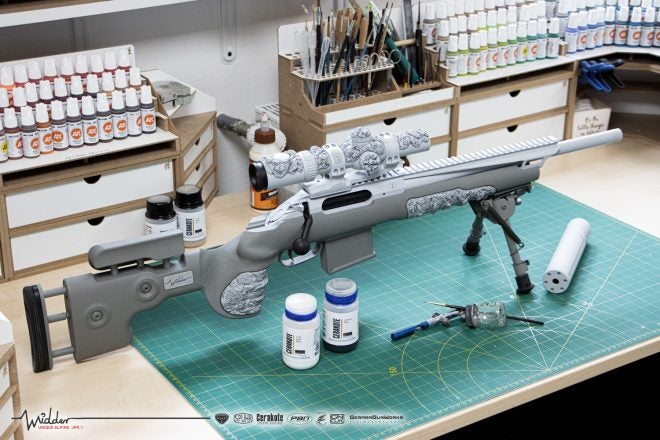
So what is the ram? A test vehicle? A decorative weapon? A new way of camouflaging service weapons?
Somehow everything applies to this new type of weapon processing and offers a completely new spectrum of possibilities that have yet to be explored. At the same time, it is undisputed that the basis, namely the JPR-1 Nordland Scout from Unique Alpine and the components used, make an excellent weapon in and of themselves.
All in all, a project that certainly deviates from the norm and clearly breaks up the sadness of the “always the same” somewhere! More of that!
Below you can find more pictures from the project.
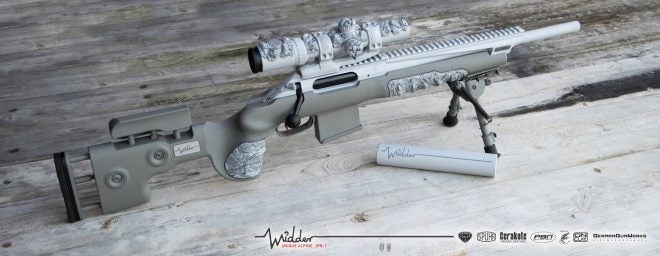
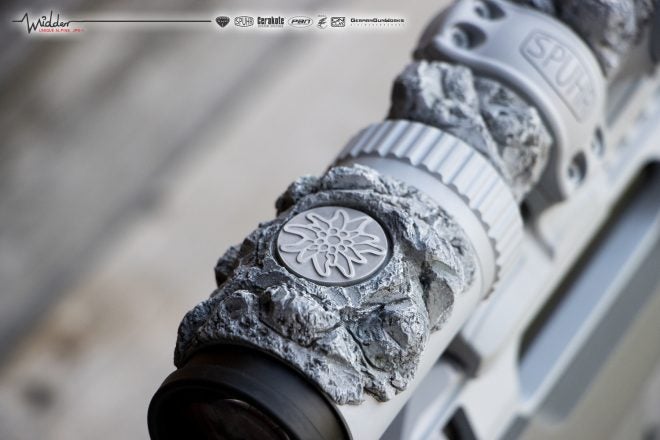
This is a Photoshop of what a desert version might look like:
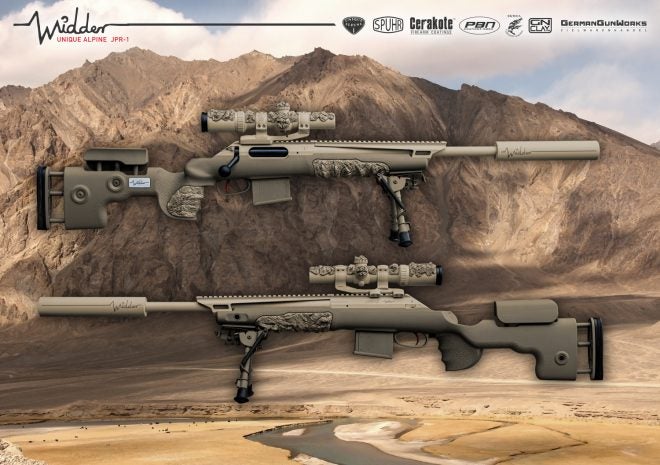
We’re quite interested in your reaction to this project and the technologies used by German GunWorks. What do you think? Is it a love or hate affair, or a mixture? Please let us know in the comments section below.
 Your Privacy Choices
Your Privacy Choices
